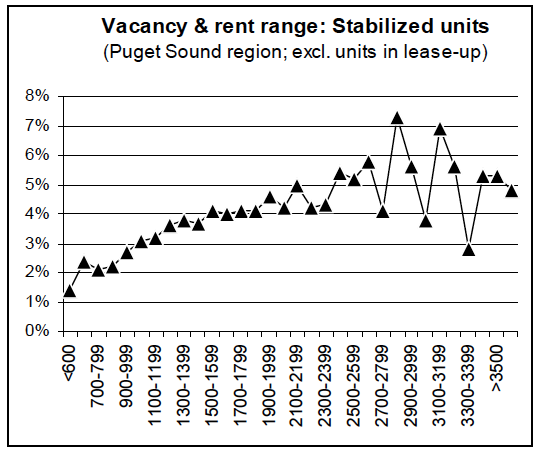Storm of the Century?: City Planners Blow the Housing Forecast and Microhousing
Apartment guru Mike Scott of Dupree + Scott has just released their latest Apartment Advisor newsletter and it is packed with lots of great data. I won’t go through his clarion explanation of supply and demand and vacancy rates (Surprise! Lower vacancy rates mean higher rents), or his discussion of the fact that rent increases aren’t keeping up with inflation since we’ve talked about these again, and again. But I want to walk through a key point about Scott’s professional view about prices and how they relate to affordability and microhousing. Scott says,
20 percent of the units in the region rent for $1,000 or less. That makes all of those units affordable to households earning at least $3,000 a month. That’s if affordability should be calculated based incomes being three times the rent.
We’re just using that amount as an example. But not everyone pays one-third of their income on rent. Some pay more. Some pay less. That means that although some households can afford to spend more than $1,000 a month, they choose to be frugal and rent an apartment for less than that.
Here Scott is starting at the same point of departure as the City when it looks at the housing issue purely as a question of how many households are paying exactly 30 percent of their income on housing; based on the way the City views the “problem,” if your household pays more, you’re cost burdened, and less, you’re camped out in an apartment that should go to someone with less income, something called “downrenting.” How many households are “cost burdened” or “downrenting?”
Greg Willett, the Chief Economist at RealPage, also spoke at WMFHA’s Washington Apartment Outlook and commented that his company did an extensive nationwide analysis of leases and found that the typical renter household spent 23% of income on rent.
We decided to do a small survey locally to see if things are different here. It was a very quick and small survey, but we found the median rent payment was 24% of income at the time of the initial lease. Only one-third of the households spent more than 30%.
We caution that this was a small survey. A more comprehensive survey will likely change the numbers. However, it still will show that a significant number of households spend less than 30% of their income on rent. That’s commendable and it should not be discouraged (emphasis is mine).
I’ve asked, mostly in a snarky way because I know they won’t answer, whether the City’s view is that if everyone paid exactly 30 percent of their monthly income on housing, would we still have a housing crisis? Of course, the answer is, “Yes,” since the only measure of the “crisis” the City bureaucrats use is exactly that, the deeply flawed Housing Cost Income Ratio model that has been with us for years and needs to be examined and changed.
We’ve pointed out before, that problems with paying rent aren’t necessarily a function of “skyrocketing rents,” but of people not having enough income to cover the costs of housing — or much of anything else. In other words, pointing out that poor people pay more of their income for housing is obvious, but blames the realities of the housing market only without looking at the broader issues of income and rising expenses for other important things.
So what are the implications of this data?
First, those households spending less than 30% of their income on rent are consuming housing that would be barely affordable for other renters. That means that however you measure the number of units that are affordable at any particular income level, some of them are occupied by households making more than that. So, you’d think that whatever developers can do to add lower cost units would be encouraged . . .
Scott goes on and points out, that
Second, it means that some renters, if not quite a few, can afford to pay more rent than they are paying now. Of course that’s just based on our simple one-third of income formula. Maybe they have the same problem U2 pointed out on their Joshua Tree album, singing, “I still haven’t found what I’m looking for.” That suggests there is room for them to move up into more expensive housing, if developers create the right kind of product and amenities in the right locations. Given how quickly new construction has been leasing up, and the high occupancy rate in these units, that may be happening now.
Again, the obvious thing to do would be to build more housing. Scott talks about the kind of housing that should be encouraged, and it’s no surprise that what would help prices would be more market rate housing that allows those people paying less but that can and might want to pay more, move to newer, more expensive units thus freeing up their unit for someone with less money.
We’re guessing that if you own a property with those lower cost, more affordable rents, you’re wondering about now why we would encourage more construction in your rent range to compete with you. Well, the simple answer is, you can handle it. Look at the Vacancy & rent range: Stabilized units chart on page 7. That’s the middle one. It shows that units renting for $1,200 a month or less don’t have a lot of vacancies.
So taken together, building new, more expensive apartment units would create a “moving on up” opportunity for some who are “down renting” and building more microhousing and Small Efficiency Dwelling Units (SEDUs) would also meet the need for the really hard to find apartments at $1200 or less. But, Scott points out,
The problem is how can developers deliver new units in that price range?
Actually, they have been doing just that with congregate housing and were ready to do more of it until Seattle balked. Ironically, as Seattle backed away from this simple affordable housing option, other cities like Tacoma, Redmond, Kirkland, and likely more to come are stepping in and embracing the concept of smaller living spaces. Their solutions are less dramatic than what Seattle developers were doing, but their problems are less dramatic as well. The point is they are jumping in while Seattle backs out.
The City is doing exactly the opposite of what Scott sees when he looks at the same data and the same measures the City uses: they are adding rules, regulations, and costs through Mandatory Inclusionary Zoning (MIZ) to new construction and eliminating the one option that would add more supply at lower price levels, microhousing. I haven’t seen a more clear example of the complete disconnect City planners and politicians have with reality and real time price and supply data. It’s all right there: build more housing of all kinds everywhere and the demand will sustain it. Instead, we’re slowing supply of regular market rate apartment units and killing off smaller, less expensive units.
Good work. Maybe the City planners should go into the weather forecasting business.



